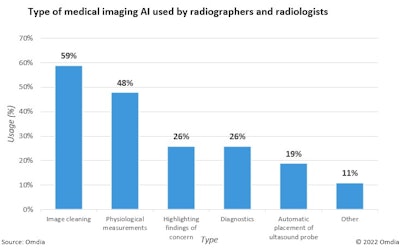
Following two gloomy years absorbed by COVID-19, the ECR returned to an in-person event this year. The pandemic has changed the way radiologists interact with patients, technology, and colleagues.
The medical imaging industry is rapidly evolving to bring to market new tools to ease the demands of medical imaging. At ECR 2022, we saw a new focus placed on artificial intelligence (AI) and digitalization and the efficiencies they can bring to radiology.
The number of diagnostic images acquired in recent years has exploded, with a 100% increase in the last 10 years, while the number of radiologists has grown at 2% over the same period. This has created high workload and stress.
At the same time, the COVID-19 pandemic has put even more pressure on radiology staff. A 2021 study conducted in the U.K. showed how the crisis had changed the clinical practice landscape in terms of working patterns and workload, causing anxiety and workplace-related stress amongst radiologic technologists.
At ECR we saw vendors demonstrating innovative solutions to address many of these challenges. Diagnostic accuracy and standardization were major ECR trends. Many medical artificial intelligence (AI) vendors and equipment manufacturers showcased upgraded hardware and solutions, with system integration a focus. Unlike healthcare enterprise solutions, medical AI is often sold as a one-off cost alongside the hardware.
Philips showcased its smart connected imaging systems and integrated radiology workflow solutions, which help to address operational inefficiencies across radiology departments. This included the SmartSpeed MRI acceleration protocol.
Meanwhile, Canon Medical Systems unveiled the Vantage Fortian MRI scanner at ECR 2022, which features accelerated scan technology.
Siemens Healthineers showed its research on the use of an AI algorithm to triage mammography exams; the tool was able to speed up efficiency by reducing patient recall rates.
Finally, GE Healthcare demonstrated a one-stop clinic for breast care, recreating the pathway a woman would take through a screening facility, from the waiting area to the pathology lab. The concept included options that allow women to customize the experience to their own preferences, such as selecting a backdrop for the mammography room from among a number of landscape photos.
Medical imaging AI continues to evolve into 2022 and beyond
We were impressed with the scale of ECR 2022 and the positivity of the atmosphere. There was also a good mix of startups, mega-corporations, and industry players in between. I often heard it said that footfall was down compared with "normal" (i.e., pre-COVID) years, but there was still a nice buzz.
Imaging AI, one of our abiding interests, was ubiquitous at ECR 2022: All major manufacturers of medical imaging equipment are now developing AI-based software for their machines. And there are many software startups in this space too, a fact that was fully on display at ECR.
How far medical imaging AI has already penetrated the market is a key question. Omdia conducted a survey of radiographers and radiologists (n = 95) that found that image cleaning was the AI application used by most imaging professionals (59% within those that had used imaging AI), with physiological measurement being the second (used by 48%).

However, 52% had never used medical imaging AI applications and 20% were not sure. Only 28% said they had actually used AI. That's no doubt huge progress compared with three years ago, but there's plenty more to do for the widespread rollout of imaging AI.
The AI paradox
So, artificial intelligence was everywhere at ECR, but it is a relatively fringe phenomenon in terms of clinical practice. What's the answer to this paradox?
We discussed this issue several times at ECR and learned that there are some fundamental issues that need to be addressed before the potential of AI is fully realized in radiology.
First, there is the crucial issue of legal liability. Software developers do not want to get sued. Human radiologists are already set up to assume legal liability in this situation: It is part of their job, and the rules are well established. It is going to take work to address the disruptive influence of AI systems in this space.
The second issue is time: Medical imaging AI is still so new that most clinics or hospital departments simply haven't had time to implement commercial AI systems yet. People are still getting used to the idea.
Our survey provides a detailed profile of the attitudes of medical imaging professionals to medical imaging AI. Overall, the results are encouraging that there is openness to medical imaging AI and that fear of "being replaced" is not very widespread. This opens the way for the ongoing deployment of medical AI systems.
Where will we be with medical imaging AI in five years, say at ECR 2027? By then, we imagine that around 80% of radiographers and radiologists will be using AI systems. AI developers will have grown in confidence and the list of applications, both under development and proposed, will have expanded, and deployment will be happening at a rapid pace.
Rapid digitization of radiology
Radiology is poised for significant change over the next 10 years. Rising labor shortages, skyrocketing demand for radiology services, and exponential growth of image data drive the adoption of digitization strategy in radiology.
From a technology standpoint, the main pillars of digitalization strategy include the following:
- Internet of medical things
- Connected medical devices and health sensors
- Cloud
- Software
- AI and data analytics
- 3D printing
- Virtual reality
ECR 2022 this year played host to key developments in the digitization of radiology. The main trends and themes include the following:
- Applications in AI-powered decision-making
- Workflow optimization
- Adoption of digital platforms
- Rise of service-based models in radiology
In the next few paragraphs, we will outline the current state of developments and industry sentiment.
Applications in AI-powered decision making
Exponential growth of medical imaging data and a shortage of radiologists remain key challenges in radiology. The focus of current AI-enabled applications showcased at ECR aim to empower radiologists with tools to make clinical decision-making faster and more accurate.
The current focus of applications is mainly on image capture and image analysis. Regarding image capture, algorithms focus on reducing image noise and improving image quality. Other add-on features include automated acquisition, patient positioning to reduce human error, and technology to lower patient radiation exposure.
Although the industry target remains the development of AI for assisted diagnosis such as early detection of abnormalities in tissue and early detection of disease, currently most AI-enabled apps focus on "soft" diagnostic applications such as filtering nonsuspicious images to allow radiologists to focus solely on suspicious cases.
Workflow optimization continues to be at the epicenter of efforts to achieve operational and clinical efficiency, and this will continue for the foreseeable future. Innovation is spread across the radiology patient journey touchpoints from acquiring patient records to patient triage to image acquisition.
Adoption of digital platforms
Digital platforms have emerged as key workflow command centers. Platforms from leading players such as Philips and GE Healthcare act as command centers encompassing diverse solutions from various vendors that aim to simplify operations across multiple modalities, create smart workflows by reducing workload, and boost workforce productivity.
At ECR 2022, vendors showed platforms that have been enriched with artificial intelligence to provide real-time contextual awareness and operational insights around imaging departments. Platforms are essentially new business propositions for the industry where radiologists, technologists, and OEMs collaborate to bring an ecosystem of applications solving critical radiology department problems.
Given the complexity and challenges ahead as well as the influence of collaborative value-based systems driven by cost containment, Omdia analysts believe that platforms are the first examples of emerging digital models in the array of service-led models coming into the market in the next five years.
The future of digital radiology is a connected, interoperable, collaborative one empowered with real-time and predictive insights supporting care collaboration across the patient journey.
Felix Beacher, Dionysia Patrinou, and Sharjeel Ahmad are market research analysts with Omdia, a division of Informa. They can be reached at [email protected].
The comments and observations expressed are those of the authors and do not necessarily reflect the opinions of AuntMinnieEurope.com.



















